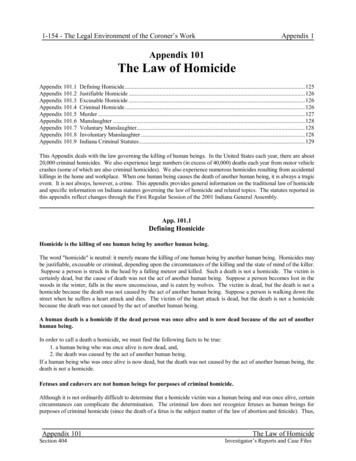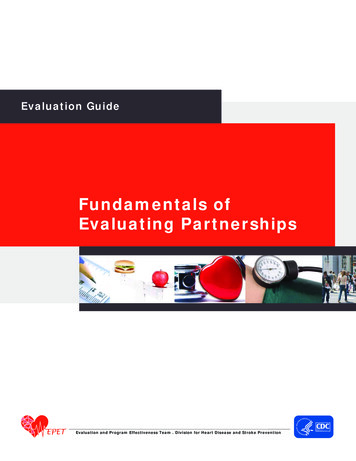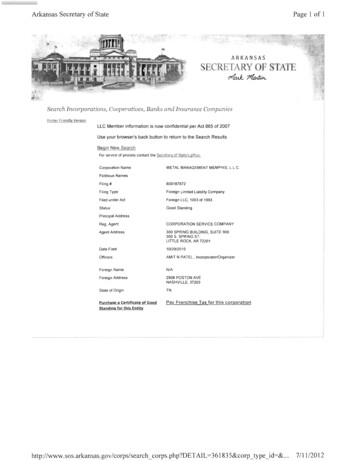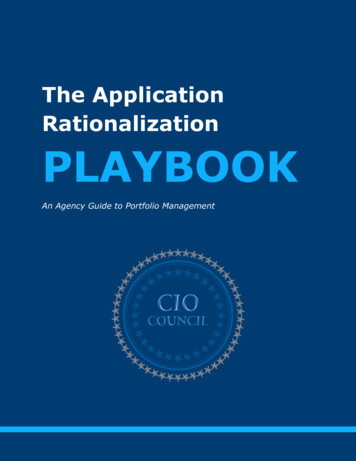
Transcription
1-154 - The Legal Environment of the Coroner’s WorkAppendix 1Appendix 101The Law of HomicideAppendix 101.1Appendix 101.2Appendix 101.3Appendix 101.4Appendix 101.5Appendix 101.6Appendix 101.7Appendix 101.8Appendix 101.9Defining Homicide.125Justifiable Homicide .126Excusable Homicide .126Criminal Homicide.126Murder .127Manslaughter .128Voluntary Manslaughter.128Involuntary Manslaughter .128Indiana Criminal Statutes.129This Appendix deals with the law governing the killing of human beings. In the United States each year, there are about20,000 criminal homicides. We also experience large numbers (in excess of 40,000) deaths each year from motor vehiclecrashes (some of which are also criminal homicides). We also experience numerous homicides resulting from accidentalkillings in the home and workplace. When one human being causes the death of another human being, it is always a tragicevent. It is not always, however, a crime. This appendix provides general information on the traditional law of homicideand specific information on Indiana statutes governing the law of homicide and related topics. The statutes reported inthis appendix reflect changes through the First Regular Session of the 2001 Indiana General Assembly.App. 101.1Defining HomicideHomicide is the killing of one human being by another human being.The word "homicide" is neutral: it merely means the killing of one human being by another human being. Homicides maybe justifiable, excusable or criminal, depending upon the circumstances of the killing and the state of mind of the killer.Suppose a person is struck in the head by a falling meteor and killed. Such a death is not a homicide. The victim iscertainly dead, but the cause of death was not the act of another human being. Suppose a person becomes lost in thewoods in the winter, falls in the snow unconscious, and is eaten by wolves. The victim is dead, but the death is not ahomicide because the death was not caused by the act of another human being. Suppose a person is walking down thestreet when he suffers a heart attack and dies. The victim of the heart attack is dead, but the death is not a homicidebecause the death was not caused by the act of another human being.A human death is a homicide if the dead person was once alive and is now dead because of the act of anotherhuman being.In order to call a death a homicide, we must find the following facts to be true:1. a human being who was once alive is now dead, and,2. the death was caused by the act of another human being.If a human being who was once alive is now dead, but the death was not caused by the act of another human being, thedeath is not a homicide.Fetuses and cadavers are not human beings for purposes of criminal homicide.Although it is not ordinarily difficult to determine that a homicide victim was a human being and was once alive, certaincircumstances can complicate the determination. The criminal law does not recognize fetuses as human beings forpurposes of criminal homicide (since the death of a fetus is the subject matter of the law of abortion and feticide). Thus,Appendix 101Section 404The Law of HomicideInvestigator’s Reports and Case Files
Appendix 1The Legal Environment of the Coroner’s Work - 1-155if the dead human being is a small baby, we must first determine that the baby was born alive and that the umbilical cordwas severed in order for that baby to have an independent existence (which was then terminated by the act of anotherhuman being). Terminating the life of a fetus is not a criminal homicide, but rather, is an abortion or feticide which maybe lawful or criminal depending upon the circumstances. A similar difficulty arises in the unusual circumstance wherea person dies of natural causes and then a would-be killer inflicts a wound on the corpse. The would-be killer certainlyintended to commit a homicide (that is, to kill another human being), but could not do so for the simple reason that theintended victim was already dead. Merely causing physical damage to a cadaver is not a homicide (but is the crime ofabuse of a corpse) because there is no living human being to kill, and the act may or may not be criminal depending uponthe circumstances. Sometimes investigators discover the physical remains of what appears to be a human being, but theremains are so badly decomposed or otherwise distorted (as by burning in a very hot fire, or dismemberment into manysmall pieces) that they are not easily identifiable as human remains. We must first find convincing evidence (typicallyfrom forensic pathologists and forensic anthropologists) that the remains were indeed human, that the human was alivewhen the lethal act was performed, and that the act of another human being caused the death.Suppose that a person is inattentive in city traffic, steps of a curb without looking, and is struck and killed by a citybus. The victim is dead, and the killing is a homicide because the cause of death is the act of another human being, thebus driver, who ran over the victim. Suppose that a police officer lawfully orders a fleeing felon to halt, but that the feloninstead turns and discharges a firearm at the police officer. The officer returns fire and kills the felon. The felon is deadand the killing is a homicide because one human being has killed another human being. Suppose an armed robber entersthe "Stop and Rob" convenience store and in the course of the robbery shoots and kills the clerk. The clerk is dead andthe killing is a homicide because the death was caused by the act of another human being.Once we have determined that a previously living human being in now dead, we must inquire into the cause of death.If the death was not caused by the act of another human being, we are no longer interested (at least from the viewpointof criminal law). If the death was probably caused by the act of another human being, we will label the death a "homicide"and then inquire into what kind of homicide it might be: justifiable, excusable, or criminal.App. 101.2Justifiable HomicideJustifiable homicides are killings which are commanded or authorized by law.Some killings of one human being by another human being are authorized or commanded by law. For example, the killingof an enemy soldier in combat by another soldier is a homicide, that is, one human being has killed another human being.However, it is a justifiable homicide because the soldier is both authorized and obligated by law to kill under thecircumstances of combat. Some killings of one human being by another human being are justifiable homicide because theyare ordered by a court. Whenever a condemned murderer is to be executed, a court must order the execution and someperson must, acting under the command and authorization of the court order, kill the condemned person (by electrocutinghim, introducing poison gas into a chamber, shooting or hanging him, or injecting him with poison). Some killings of onehuman being by another human being are authorized by law because of the peculiar circumstances of the killing. Supposea person awakens in his own bedroom to discover a stranger present. The stranger is apparently armed with a deadlyweapon and is offering to kill the homeowner in his bed. The homeowner reaches into his night stand, removes a pistol,and shoots the intruder dead. This is a homicide, because one human being has killed another human being, but it is ajustifiable homicide because killings in self-defense when the killer reasonably fears for his life and has no reasonablealternative but to use deadly force are authorized by law.If the killer has no criminal intent, and the killing occurs under circumstances where killings of other human beingsare either commanded or authorized by law, the killing is called a justifiable homicide.App. 101.3Excusable HomicideExcusable homicides are killings of human beings which are not deserving of punishment.Appendix 101The Law of Homicide
156Appendix 1 The Legal Environment of the Coroner’s WorkSome killings of one human being by another human being, although not commanded or authorized by law, arenonetheless killings for which we do not wish to punish the killer. Such killings are termed excusable homicides.Typically, excusable homicides are killings which result from accident or inadvertence, or they are killings done bypersons who lack the capacity to commit crimes (such as very young children or persons who are legally insane).Suppose two professional boxers are engaged in a licensed boxing match. One boxer strikes the other who collapsesin the ring and dies. The surviving boxer did not mean to kill his opponent, merely to strike him within the rules of theboxing contest. This killing is certainly a homicide, that is, the act of one human being has caused the death of anotherhuman being. This killing is certainly not a justifiable homicide because the killing of one boxer by another in the prizering is not commanded or authorized by law. Such a killing is, however, an excusable homicide because it is a killing byinadvertence and without criminal intent on the part of the killer.Suppose that you are driving your automobile down a city street on a bright, dry day. You are obeying all traffic rulesand you are attentive to your driving. Suddenly, a small child runs from between parked cars just a few feet from yourfront bumper. Despite your best efforts, your car strikes and kills the child. You have committed a homicide because youract of driving your car into the child caused the child's death. The homicide is certainly not a justifiable homicide becausethe law does not command or authorize you to run over children with your car. It is, however, an excusable homicidebecause it is a killing by accident without criminal intent and without criminal negligence.App. 101.4Criminal HomicideA criminal homicide is any unjustified, unexcused killing of one human being by another human being.A criminal homicide is any killing of one human being by another human being which is not justifiable and not excusable.Criminal homicides may be intentional killings or killings by accident or killings which result from criminal negligencedepending upon the circumstances of the killing and the state of mind of the killer. Criminal homicides come in two basicvarieties: murder and manslaughter.Murder is the unjustified, unexcused killing of one human being by another human being with malice aforethought.Manslaughter is the unjustified, unexcused killing of one human being by another human being without maliceaforethought.App. 101.5MurderMurder is the unjustified, unexcused killing of one human being by another human being with maliceaforethought.Malice aforethought is a state of mind which distinguishes murders from manslaughters. It is a technical term which issomewhat confusing at first because it does not mean exactly what is seems. Malice aforethought does not require thatthe killer be angry or vindictive toward his victim, nor does it require that the killer think about what he is doing beforehe does it. Rather, malice aforethought is a technical term which includes five distinct states of mind. A prosecutor mustprove any one of these states of mind to establish that a killer had malice aforethought when he killed. Any one of thefollowing states of mind constitute malice aforethought:1. the intent to kill;2. the intent to do great bodily harm;3. the intent to resist lawful arrest;4. the intent to commit an inherently dangerous felony; and5. the intent to do any act with such a reckless disregard for the probability of the death of another human being asto be the equivalent of an intent to kill (the shorthand term for this is the "abandoned and malignant heart").Malice aforethought as the intent to kill is fairly easy to understand: the killer deliberately sets out to terminate theAppendix 101The Law of Homicide
Appendix 1 The Legal Environment of the Coroner’s Work157life of his victim. We determine an intent to kill (as we do any other state of mind) by inferring it from the behavior ofthe accused. Thus, if the evidence shows that the accused pointed a pistol at his victim, pulled the trigger, and dischargeda bullet into the victim's head, causing death, it seems reasonable for us to infer that the accused intended to kill his victim.We know from ordinary human experience that persons who use deadly weapons against other persons usually intendto kill.Malice aforethought as the intent to do great bodily harm is a little less obvious. This definition of maliceaforethought covers situations where the accused contends that he did not really mean to kill the victim. The state of mindof the accused is still malice aforethought, however, if the accused intended to do great bodily harm to the victim (e.g.,by torture, poisoning, running over with a car) and the victim dies as a result. No specific intent to kill is required so longas the prosecutor can prove that the accused intended to inflict the harm which, in fact, resulted in the victim's death.Traditionally, the intent to resist lawful arrest has been defined as malice aforethought for the protection of policeofficers and other public officials with arrest powers. Suppose a police officer attempts to serve a valid arrest warrant,and the person to be arrested resists by lightly pushing the officer away. The officer stumbles, falls, and strikes his headon the concrete curb. As a result of this fall, the officer dies from a fractured skull. Even this accidental death would bea murder because the accused intended to resist a lawful arrest (by failing to submit) and a result of that resistance wasthe death of the police officer.Malice aforethought as the intent to commit an inherently dangerous felony is referred to as the felony-murder rule.When a person voluntarily commits an inherently dangerous felony (that is, a felony likely to result in the use of forceor resistance by the victim, such as robbery, rape, or aggravated assault), that person knows that a foreseeable result ofthe commission of the felony is the killing of another human being. Traditionally, any death resulting from thecommission or attempted commission of an inherently dangerous felony has been defined as a murder. This is true evenwhere the killing is accidental, and where the decedent is the intended victim of the felony, or a bystander, or even anaccomplice of the accused.Finally, malice aforethought as the "abandoned and malignant heart" includes rather unusual situations involving nospecific intent to kill or even harm a victim, but where the behavior of the accused is so reckless as to amount to thefunctional equivalent of an intent to kill. A common situation where a court might find the "abandoned and malignantheart" state of mind to exist would be where a person throws a concrete block from an expressway overpass and strikesa passing vehicle, causing the driver to crash and die. Another example of this extreme kind of life-threateningrecklessness would be where a person, wishing to test the accuracy of his new pistol, fires several shots at a passing citybus, striking and killing a passenger. In these cases, there is no focused intent to kill or even to injure another person, butthe behavior of the accused in killing his victim is so extreme and so unreasonable that is would be apparent that a deathwould be the likely result of the conduct.App. 101.6ManslaughterManslaughter is the unjustified, unexcused killing of one human being by another human being without maliceaforethought.If the prosecutor can prove that the accused, without justification and without excuse, did an act which caused the deathof the victim, and that the accused had any one of the five states of mind that constitute malice aforethought, then theaccused is guilty of murder. If the prosecutor can prove that the accused, without justification or excuse, did an act whichcaused the death of the victim, but cannot prove that the accused has one of the five states of mind which constitute maliceaforethought, then the accused is guilty of manslaughter.Manslaughter is the unjustified, unexcused killing of one human being by another human being without maliceaforethought, and it comes in two varieties: voluntary manslaughter and involuntary manslaughter.Appendix 101The Law of Homicide
158Appendix 1 The Legal Environment of the Coroner’s WorkApp. 101.7Voluntary ManslaughterVoluntary manslaughter is the unjustified, unexcused, intentional killing of one human being by another humanbeing without malice aforethought and with heat of passion (or heat of blood or sudden heat).Voluntary manslaughter is the unjustified, unexcused, intentional killing of one human being by another human beingwithout malice aforethought and where the following elements are present:1. there was an adequate provocation of the accused which would be sufficient to enrage any reasonable person;2. the accused, because of the provocation, attained a mental state referred to as heat of passion, heat of blood, orsudden heat;3. the killing of the victim was sudden with no cooling off; and4. there was a causal connection between the provocation, the heat of passion, and the killing.In such a case, what would otherwise be a murder becomes a voluntary manslaughter. In the case of voluntarymanslaughter, the "intent" to kill is the product of rage producing a non-rational state of mind. The intent to kill necessaryto prove malice aforethought for murder is a cool, deliberate intent. The law has traditionally distinguished between the"cold blooded" killing and the killing which is the product of anger by providing a lesser punishment for voluntarymanslaughter.App. 101.8Involuntary ManslaughterInvoluntary manslaughter is the unjustified, unexcused, unintentional killing of one human being by anotherhuman being without malice aforethought.Involuntary manslaughter is the unjustified, unexcused, unintentional killing of one human being by another human beingwithout malice aforethought and where the killing results from either:1. the doing of an unlawful act (not a dangerous felony); or2. the doing of a lawful act in a criminally negligent manner.A simple battery (striking another person) is only a misdemeanor yet can result in death under certain circumstances.When it does, the death is unintentional and the crime is involuntary manslaughter. Likewise, a person might engage inan act with extreme carelessness (but not so reckless as to constitute the abandoned and malignant heart) and cause adeath; an accidental shooting which results from horseplay with a firearm would be an example.Most states also have a special statutory form of involuntary manslaughter to cover the very common situation wherethe accused has killed the victim through the operation of a motor vehicle. Such a specialized statutory crime is variouslycalled just involuntary manslaughter, involuntary manslaughter by motor vehicle, reckless homicide, or vehicularhomicide, depending upon the jurisdiction's particular statutory definition. In many states, causing death by the operationof a motor vehicle by ordinary (i.e., non-criminal) negligence constitutes a misdemeanor form of involuntarymanslaughter, the only instance of a criminal homicide which is treated as a misdemeanor.App. 101.9Appendix 101The Law of Homicide
Appendix 1 The Legal Environment of the Coroner’s Work159Indiana Criminal StatutesApp. 101.9.1Criminal Jurisdiction of the State of IndianaIC 35-41-1-1. (a) As used in this section, "Indiana" includes:(1) The area within the boundaries of the state of Indiana, as set forth in Article 14, Section 1 of the Constitution ofthe State of Indiana;(2) The portion of the Ohio River on which Indiana possesses concurrent jurisdiction with the state of Kentucky underArticle 14, Section 2 of the Constitution of the State of Indiana; and(3) The portion of the Wabash River on which Indiana possesses concurrent jurisdiction with the state of Illinoisunder Article 14, Section 2 of the Constitution of the State of Indiana.(b) A person may be convicted under Indiana law of an offense if:(1) Either the conduct that is an element of the offense, the result that is an element, or both, occur in Indiana;(2) Conduct occurring outside Indiana is sufficient under Indiana law to constitute an attempt to commit an offensein Indiana;(3) Conduct occurring outside Indiana is sufficient under Indiana law to constitute a conspiracy to commit an offensein Indiana, and an overt act in furtherance of the conspiracy occurs in Indiana;(4) Conduct occurring in Indiana establishes complicity in the commission of, or an attempt or conspiracy to commit,an offense in another jurisdiction that also is an offense under Indiana law; or(5) The offense consists of the omission to perform a duty imposed by Indiana law with respect to domicile,residence, or a relationship to a person, thing, or transaction in Indiana.(c) When the offense is homicide, either the death of the victim or bodily impact causing death constitutes a result undersubsection (b)(1). If the body of a homicide victim is found in Indiana, it is presumed that the result occurred in Indiana.App. 101.9.2Basis of Criminal LiabilityIC 35-41-2-1. (a) A person commits an offense only if he voluntarily engages in conduct in violation of the statutedefining the offense. However, a person who omits to perform an act commits an offense only if he has a statutory,common law, or contractual duty to perform the act.(b) If possession of property constitutes any part of the prohibited conduct, it is a defense that the person who possessedthe property was not aware of his possession for a time sufficient for him to have terminated his possession.IC 35-41-2-2. (a) A person engages in conduct "intentionally" if, when he engages in the conduct, it is his consciousobjective to do so.(b) A person engages in conduct "knowingly" if, when he engages in the conduct, he is aware of a high probability thathe is doing so.(c) A person engages in conduct "recklessly" if he engages in the conduct in plain, conscious, and unjustifiable disregardof harm that might result and the disregard involves a substantial deviation from acceptable standards of conduct.(d) Unless the statute defining the offense provides otherwise, if a kind of culpability is required for commission of anoffense, it is required with respect to every material element of the prohibited conduct.IC 35-41-2-3. (a) A corporation, limited liability company, partnership, or unincorporated association may be prosecutedfor any offense; it may be convicted of an offense only if it is proved that the offense was committed by its agent actingwithin the scope of his authority.(b) Recovery of a fine, costs, or forfeiture from a corporation, limited liability company, partnership, or unincorporatedassociation is limited to the property of the corporation, limited liability company, partnership, or unincorporatedassociation.App. 101.9.3Defenses Relating to CulpabilityIC 35-41-3-1. A person is justified in engaging in conduct otherwise prohibited if he has legal authority to do so.IC 35-41-3-2. (a) A person is justified in using reasonable force against another person to protect himself or a thirdAppendix 101The Law of Homicide
160Appendix 1 The Legal Environment of the Coroner’s Workperson from what he reasonably believes to be the imminent use of unlawful force. However, a person is justified in usingdeadly force only if he reasonably believes that that force is necessary to prevent serious bodily injury to himself or a thirdperson or the commission of a forcible felony. No person in this state shall be placed in legal jeopardy of any kindwhatsoever for protecting himself or his family by reasonable means necessary.(b) A person is justified in using reasonable force, including deadly force, against another person if he reasonably believesthat the force is necessary to prevent or terminate the other person's unlawful entry of or attack on his dwelling orcurtilage.(c) With respect to property other than a dwelling or curtilage, a person is justified in using reasonable force againstanother person if he reasonably believes that the force is necessary to immediately prevent or terminate the other person'strespass on or criminal interference with property lawfully in his possession, lawfully in possession of a member of hisimmediate family, or belonging to a person whose property he has authority to protect. However, a person is not justifiedin using deadly force unless that force is justified under subsection (a) of this section.(d) Notwithstanding subsections (a), (b), and (c) of this section, a person is not justified in using force if:(1) He is committing, or is escaping after the commission of, a crime;(2) He provokes unlawful action by another person, with intent to cause bodily injury to the other person; or(3) He has entered into combat with another person or is the initial aggressor, unless he withdraws from the encounterand communicates to the other person his intent to do so and the other person nevertheless continues or threatens tocontinue unlawful action.IC 35-41-3-3. (a) A person other than a law enforcement officer is justified in using reasonable force against anotherperson to effect an arrest or prevent the other person's escape if:(1) A felony has been committed; and(2) There is probable cause to believe the other person committed that felony.However, such a person is not justified in using deadly force unless that force is justified under section 2 [IC 35-41-3-2]of this chapter.(b) A law enforcement officer is justified in using reasonable force if the officer reasonably believes that the force isnecessary to effect a lawful arrest. However, an officer is justified in using deadly force only if the officer:(1) Has probable cause to believe that that deadly force is necessary:(A) To prevent the commission of a forcible felony; or(B) To effect an arrest of a person who the officer has probable cause to believe poses a threat of serious bodilyinjury to the officer or a third person; and(2) Has given a warning, if feasible, to the person against whom the deadly force is to be used.(c) A law enforcement officer making an arrest under an invalid warrant is justified in using force as if the warrant wasvalid, unless the officer knows that the warrant is invalid.(d) A law enforcement officer who has an arrested person in custody is justified in using the same force to prevent theescape of the arrested person from custody that the officer would be justified in using if the officer was arresting thatperson. However, an officer is justified in using deadly force only if the officer:(1) Has probable cause to believe that deadly force is necessary to prevent the escape from custody of a person whothe officer has probable cause to believe poses a threat of serious bodily injury to the officer or a third person; and(2) Has given a warning, if feasible, to the person against whom the deadly force is to be used.(e) A guard or other official in a penal facility or a law enforcement officer is justified in using reasonable force, includingdeadly force, if the officer has probable cause to believe that the force is necessary to prevent the escape of a person whois detained in the penal facility.(f) Notwithstanding subsection (b), (d), or (e), a law enforcement officer who is a defendant in a criminal prosecution hasthe same right as a person who is not a law enforcement officer to assert self-defense under IC 35-41-3-2.IC 35-41-3-4. [Repealed.]IC 35-41-3-5. It is a defense that the person who engaged in the prohibited conduct did so while he was intoxicated, onlyif the intoxication resulted from the introduction of a substance into his body:(1) without his consent; or(2) when he did not know that the substance might cause intoxication.Appendix 101Section 404The Law of HomicideInvestigator’s Reports and Case Files
Appendix 1 The Legal Environment of the Coroner’s Work161IC 35-41-3-6. (a) A person is not responsible for having engaged in prohibited conduct if, as a result of mental diseaseor defect, he was unable to appreciate the wrongfulness of the conduct at the time of the offense.(b) As used in this section, "mental disease or defect" means a severely abnormal mental condition that grossly anddemonstrably impairs a person's perception, but the term does not include an abnormality manifested only by repeatedunlawful or antisocial conduct.IC 35-41-3-7. It is a defense that the person who engaged in the prohibited conduct was reasonably mistaken about amatter of fact, if the mistake negates the culpability required for commission of the offense.IC 35-41-3-8. (a) It is a defense that the person who engaged in the prohibited conduct was compelled to do so by threatof imminent serious bodily injury to himself or another person. With resp
Appendix 1 The Legal Environment of the Coroner’s Work - 1-155 Appendix 101 The Law of Homicide if the dead human being is a small baby, we must first determine










